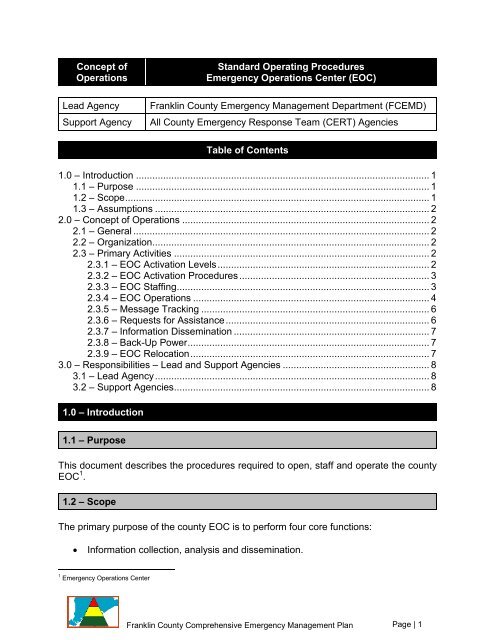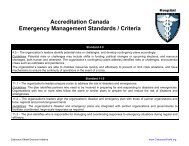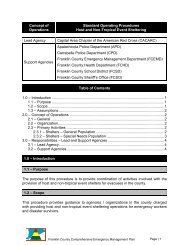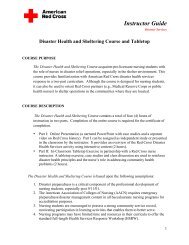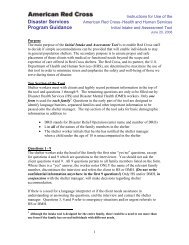Standard Operating Procedures Emergency Operations Center
Standard Operating Procedures Emergency Operations Center
Standard Operating Procedures Emergency Operations Center
Create successful ePaper yourself
Turn your PDF publications into a flip-book with our unique Google optimized e-Paper software.
Concept of<br />
<strong>Operations</strong><br />
Lead Agency<br />
Support Agency<br />
<strong>Standard</strong> <strong>Operating</strong> <strong>Procedures</strong><br />
<strong>Emergency</strong> <strong>Operations</strong> <strong>Center</strong> (EOC)<br />
Franklin County <strong>Emergency</strong> Management Department (FCEMD)<br />
All County <strong>Emergency</strong> Response Team (CERT) Agencies<br />
Table of Contents<br />
1.0 – Introduction ............................................................................................................ 1<br />
1.1 – Purpose ............................................................................................................ 1<br />
1.2 – Scope ................................................................................................................ 1<br />
1.3 – Assumptions ..................................................................................................... 2<br />
2.0 – Concept of <strong>Operations</strong> ........................................................................................... 2<br />
2.1 – General ............................................................................................................. 2<br />
2.2 – Organization ...................................................................................................... 2<br />
2.3 – Primary Activities .............................................................................................. 2<br />
2.3.1 – EOC Activation Levels .............................................................................. 2<br />
2.3.2 – EOC Activation <strong>Procedures</strong> ...................................................................... 3<br />
2.3.3 – EOC Staffing ............................................................................................. 3<br />
2.3.4 – EOC <strong>Operations</strong> ....................................................................................... 4<br />
2.3.5 – Message Tracking .................................................................................... 6<br />
2.3.6 – Requests for Assistance ........................................................................... 6<br />
2.3.7 – Information Dissemination ........................................................................ 7<br />
2.3.8 – Back-Up Power ......................................................................................... 7<br />
2.3.9 – EOC Relocation ........................................................................................ 7<br />
3.0 – Responsibilities – Lead and Support Agencies ...................................................... 8<br />
3.1 – Lead Agency ..................................................................................................... 8<br />
3.2 – Support Agencies .............................................................................................. 8<br />
1.0 – Introduction<br />
1.1 – Purpose<br />
This document describes the procedures required to open, staff and operate the county<br />
EOC 1 .<br />
1.2 – Scope<br />
The primary purpose of the county EOC is to perform four core functions:<br />
• Information collection, analysis and dissemination.<br />
1 <strong>Emergency</strong> <strong>Operations</strong> <strong>Center</strong><br />
Franklin County Comprehensive <strong>Emergency</strong> Management Plan<br />
Page | 1
• Coordination.<br />
• Communications.<br />
• Resource requesting, dispatching and tracking.<br />
1.3 – Assumptions<br />
The county EOC is the focal point of the county’s coordination of disaster response and<br />
recovery activities during and after disasters and emergencies.<br />
2.0 – Concept of <strong>Operations</strong><br />
2.1 – General<br />
To ensure the needs of the county are met by providing a Unified Command among the<br />
various government agencies and community and faith based organizations assigned<br />
lead and / or support responsibilities in the county’s CEMP 2 .<br />
2.2 – Organization<br />
The county’s EOC utilizes the ICS 3 structure during all activations.<br />
2.3 – Primary Activities<br />
2.3.1 – EOC Activation Levels<br />
The level of the county EOC activation will depend on the nature and scope of the threat<br />
to the county.<br />
Localized flooding may require only a minimal activation of the county EOC, while an<br />
impending hurricane landfall would require full activation of the county EOC.<br />
County EOC activation levels are:<br />
• Level 1 – Full Scale Activation – All ESFs Activated.<br />
• Level 2 – Partial Activation – Some ESFs activated.<br />
• Level 3 – Monitoring.<br />
On a daily basis the county EOC is at Level 3 activation.<br />
Coordination with the SWO 4 or SEOC 5 is critical at all levels to ensure the accurate<br />
communication of information and quick response to the emergency.<br />
2 Comprehensive <strong>Emergency</strong> Management Plan<br />
3 Incident Command System<br />
Franklin County Comprehensive <strong>Emergency</strong> Management Plan<br />
Page | 2
2.3.2 – EOC Activation <strong>Procedures</strong><br />
The FCEMD notifies the BOCC 6 that the county EOC is being partially or fully activated.<br />
Upon the request from the FCEMD Director or designee the BOCC meets either in<br />
person or via conference call to officially declare a Local State of <strong>Emergency</strong>.<br />
FCEMD notifies the SWO or the SEOC that a Local State of <strong>Emergency</strong> has been<br />
declared and the county EOC has been partially or fully activated.<br />
The FCEMD ensures that the county EOC is ready to receive staff to support the<br />
various functions of the county EOC:<br />
• Office supplies are available.<br />
• Required forms are available.<br />
• <strong>Emergency</strong> plans and SOPs are available.<br />
• Notification and Resource Directories are available.<br />
• Communications systems are operational.<br />
2.3.3 – EOC Staffing<br />
Agency Staffing<br />
The FDEMD will make the determination of which lead and support agencies are<br />
needed in the county EOC based on the level of activation and the scope of the event.<br />
Contacting Agencies<br />
The FCEMD will contact all pertinent lead and support agencies to provide them with<br />
situational awareness of conditions in the county.<br />
Based on the level of activation and the scope of the event, FCEMD will request staff<br />
from appropriate lead and support agencies be assigned to the county EOC.<br />
Staffing Pattern<br />
Staffing patterns will be at the discretion of the FCEMD and will depend on the specifics<br />
of each incident.<br />
For prolonged county EOC activations such as hurricanes and floods, staff assigned to<br />
the county EOC will work in shifts to allow for adequate periods of rest.<br />
4 State Watch Office<br />
5 State <strong>Emergency</strong> <strong>Operations</strong> <strong>Center</strong><br />
6 Board of County Commissioners<br />
Franklin County Comprehensive <strong>Emergency</strong> Management Plan<br />
Page | 3
Staff Support<br />
The FCEMD will provide food and beverages for staff working in the county EOC. Food<br />
and beverages will be obtained from local vendors at the direction of the FCEMD.<br />
The county EOC is equipped with a bunk room for sleeping and a shower for personal<br />
hygiene.<br />
2.3.4 – EOC <strong>Operations</strong><br />
Incident Command<br />
The FCEMD Director or designee is responsible for supervising all county EOC<br />
activities.<br />
Incident Command System<br />
The ICS is the emergency management organizational system used in county during<br />
emergency situations.<br />
The ICS allows for the expansion or contraction of the ICS structure according to the<br />
demands of the incident. This management system can be used to manage incidents<br />
ranging in scope from a vehicular accident to a major hurricane.<br />
In the ICS, the IC 7 has overall responsibility for the incident. Agencies involved in<br />
responding to the incident are organized into four sections:<br />
• <strong>Operations</strong><br />
• Logistics<br />
• Infrastructure<br />
• Finance<br />
Each of these sections can have a Section Chief who, in a major event would<br />
coordinate the actions of the units within that section and serve as liaison with the IC.<br />
Section Chiefs will be appointed at the discretion of the IC based upon the scope of the<br />
incident and their individual skills and knowledge.<br />
The FCEMD Director or designee will serve as the IC for the county EOC.<br />
Each section within the ICS contains functional responsibilities that can be matched with<br />
corresponding ESFs 8 in the state CEMP.<br />
7 Incident Commander<br />
8 <strong>Emergency</strong> Support Function<br />
Franklin County Comprehensive <strong>Emergency</strong> Management Plan<br />
Page | 4
In the ICS used by the county, depending on the scope of the disaster, one agency may<br />
be responsible for several tasks. For example, the FCSO is responsible for maintaining<br />
communications, conducting SAR 9 operations, assisting in evacuation and re-entry<br />
activities and conducting law enforcement and security operations. The FCSO also<br />
provides support for several other agencies during emergency operations.<br />
Response / Recovery Activities<br />
The FCEMD Director or designee has the primary responsibility for coordinating<br />
disaster response and recovery operations in the County.<br />
• <strong>Operations</strong> Section<br />
This section plays a major role during the response phase of an emergency. The<br />
<strong>Operations</strong> Section is responsible for the following types of activities:<br />
o ESF # 2 – Communications<br />
o ESF # 4 – Firefighting<br />
o ESF # 6 – Mass Care<br />
o ESF # 8 – Health and Medical<br />
o ESF # 9 – Search and Rescue<br />
o ESF # 10 – Hazardous Materials<br />
o ESF # 13 – Military Support<br />
o ESF # 16 – Law Enforcement<br />
o ESF # 17 – Animal Protection<br />
Lead and support agencies for each of the activities can be found in the<br />
corresponding ESF Concept of <strong>Operations</strong> documents.<br />
• Logistics Section<br />
This section is responsible for obtaining logistical support during all phases of<br />
disaster operations. This includes obtaining the equipment and personnel<br />
resources required to address local needs from government agencies,<br />
community and faith based organizations along with private companies involved<br />
in response and recovery activities. This section is responsible for the following<br />
types of activities:<br />
o ESF # 1 – Transportation<br />
o ESF # 5 – Information and Planning<br />
o ESF # 7 – Resource Support<br />
o ESF # 11 – Food and Water<br />
o ESF # 14 – Public Information<br />
o ESF # 15 – Volunteers and Donations<br />
9 Search and Rescue<br />
Franklin County Comprehensive <strong>Emergency</strong> Management Plan<br />
Page | 5
o ESF # 18 – Business and Industry<br />
Lead and support agencies for each of the activities can be found in the<br />
corresponding ESF Concept of <strong>Operations</strong> documents.<br />
• Infrastructure Section<br />
This section is responsible for maintaining infrastructure critical for supporting<br />
rapid response and recovery operations. This section is responsible for the<br />
following types of activities:<br />
o ESF # 3 – Public Works<br />
o ESF # 12 – Utilities<br />
Lead and support agencies for each of the activities can be found in the<br />
corresponding ESF Concept of <strong>Operations</strong> documents.<br />
• Finance<br />
This section is responsible for maintaining critical records in regards to all costs<br />
associated with the county’s response and recovery activities.<br />
2.3.5 – Message Tracking<br />
Incoming messages to the county’s EOC will captured in writing utilizing ICS Form #<br />
213 (General Messages). Upon completion of this form it will be forwarded to the<br />
FCEMD Director or designee for appropriate action and dissemination.<br />
Incoming messages will be saved in the appropriate disaster operations file.<br />
The FCEMD Director or designee will review and approve all outgoing messages prior<br />
to being sent.<br />
After outgoing messages have been sent, they will be saved in the appropriate disaster<br />
operations file.<br />
2.3.6 – Requests for Assistance<br />
The FCEMD will be responsible for requesting assistance from agencies / organizations<br />
within the county to address equipment and personnel resource needs during a<br />
disaster.<br />
Requests for assistance will be recorded on ICS Form # 308 (Resource Request Form)<br />
and reviewed by the FCEMD Director or designee.<br />
Franklin County Comprehensive <strong>Emergency</strong> Management Plan<br />
Page | 6
If the FCEMD Director or designee approves the request for assistance and it can be<br />
met with local resources, the task will be assigned to the appropriate local agency /<br />
organization to be carried out.<br />
The FCEMD’s Notification and Resource Directories provide a comprehensive listing of<br />
agencies and organizations and the resources available within the county. These should<br />
be the first resources consulted to determine if a need can be addressed locally.<br />
If the request cannot be met within the county and requires outside assistance, then it<br />
will be forwarded to the appropriate ESF at the SEOC. The original message requesting<br />
assistance will be placed in the appropriate disaster operations file.<br />
FCEMD will track the request via EM Constellation once it has been submitted to the<br />
SEOC and will keep the requesting agency / organization informed as to the status of<br />
the request.<br />
2.3.7 – Information Dissemination<br />
A daily county EOC briefing will be held to update agencies / organizations on the status<br />
of emergency operations. Additional daily briefings will be scheduled as necessary.<br />
A daily Situation Report will be prepared utilizing ICS Form # 201 (Incident Briefing) and<br />
posted in EM Constellation or forwarded to the SEOC. Additional Situation Reports will<br />
be provided and disseminated as warranted.<br />
Information will be disseminated to the public through the county’s PIO 10 . Information<br />
will be disseminated through available media outlets. Contact information for the media<br />
is available in the FCEMD Notification Directory.<br />
Additional means of disseminating information to the public include:<br />
• Wireless <strong>Emergency</strong> Notification System (WENS)<br />
• Direct phone calls to Special Needs clients.<br />
• E-Mails to various businesses, agencies and organizations.<br />
• Broadcast sirens from law enforcement and fire department vehicles.<br />
• Door to door notification using law enforcement officers, local government<br />
employees and / or VFDs.<br />
2.3.8 – Back-Up Power<br />
The county EOC has a generator and a seven-day supply of diesel on-site.<br />
2.3.9 – EOC Relocation<br />
10 Public Information Officer<br />
Franklin County Comprehensive <strong>Emergency</strong> Management Plan<br />
Page | 7
The alternate county EOC is located at the FCSO located on St Rd 65, two miles north<br />
of Eastpoint. This facility is located in a category five hurricane storm surge zone. The<br />
wind rating of the roof has not been determined, but is believed to be approximately 110<br />
MPH.<br />
This facility has phones, computers, tables and chairs.<br />
Should it become necessary to relocate the county EOC, the following steps should be<br />
followed:<br />
• The FCEMD Director or designee will dispatch staff to the alternate county EOC<br />
to ensure that it is ready for operation.<br />
• FCEMD staff will bring laptop computers, cellular phones, office supplies,<br />
required forms, emergency plans and SOPs along with Notification and<br />
Resources Directories to the alternate county EOC.<br />
• FCEMD staff will notify the SEOC and all local lead and support agencies that<br />
the primary county EOC is relocating to the alternate county EOC.<br />
• Upon arriving at the alternate county EOC, FCEMD staff will contact all<br />
appropriate lead and support agencies and provide them with phone numbers to<br />
reach the alternate county EOC.<br />
3.0 – Responsibilities – Lead and Support Agencies<br />
3.1 – Lead Agency<br />
Franklin County <strong>Emergency</strong> Management Department – Is responsible for<br />
supervising all activities within the county EOC during all levels of activation.<br />
3.2 – Support Agencies<br />
All County <strong>Emergency</strong> Response Team (CERT) Agencies<br />
Franklin County Comprehensive <strong>Emergency</strong> Management Plan<br />
Page | 8


